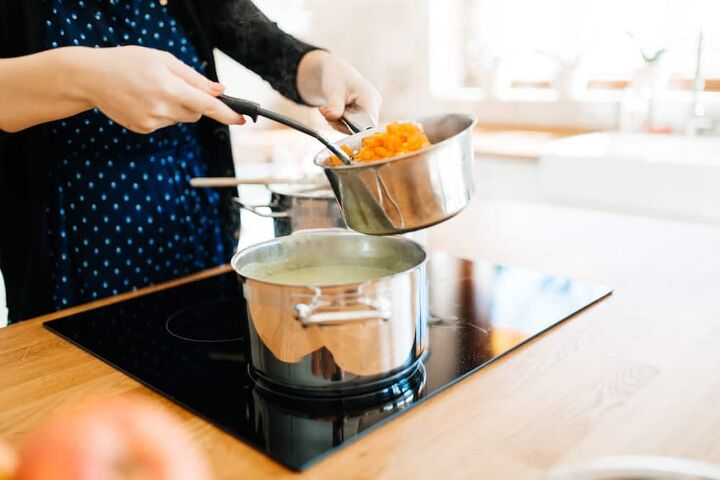If you have non induction cookware and want to use it on an induction cooktop, there are a few things you need to know. Induction cooktops work by using a magnetic field to generate heat directly in the cookware. This means that the cooktop itself stays cool to the touch and is very energy efficient.
In order to use non induction cookware on an induction cooktop, you will need to use a magnetic skillet or stove top adapter.
- Place the cookware on the cooktop
- Turn on the cooktop to the desired heat setting
- Place your food in the cookware
- Cook your food according to your recipe
- When finished, turn off the cooktop and remove the cookware
How to Use a Non-Induction Cookware on Induction Cooktop
Can I Use Normal Cookware on Induction Cooktop?
Yes, you can use normal cookware on an induction cooktop, as long as it is made of a ferrous material. This means that your cookware must be made of iron or have a steel or cast-iron core. Stainless steel cookware also works with induction cooking, as long as the bottom of the pan is flat and smooth.
Can You Use Nonstick Pans on an Induction Cooktop?
If you’re like most people, you probably have a few nonstick pans in your kitchen. But can you use them on an induction cooktop?
The short answer is yes, but there are a few things to keep in mind.
First, not all nonstick pans are created equal. Some have coatings that are more durable than others and can withstand the higher temperatures generated by an induction cooktop. Second, even the most durable nonstick coatings will eventually start to wear down and will need to be replaced.
So if you want to use a nonstick pan on an induction cooktop, it’s important to choose one with a quality coating and be prepared to replace it when necessary. With that said, let’s take a closer look at how induction cooking works and how it can impact your nonstick pans.
Induction cooking uses magnetic fields to generate heat directly in the cookware itself.
This means that the cooktop stays cool to the touch while the pan gets hot – making it a safer option than traditional gas or electric stoves. Induction cooks food faster than other methods as well, so it’s important to use cookware that can withstand high temperatures without warping or melting.
Nonstick surfaces are made up of tiny pores that release food easily when cooked.
However, these same pores can also trap oils and other liquids from seeping into the surface of the pan. Over time, this build-up can cause sticking and make it difficult to clean the pan properly. Additionally, if heated too high, nonstick surfaces can start to break down and release harmful chemicals into the air – which is why it’s important to only use them at lower temperatures.
So what does this all mean for using anon stick panon an induction cooktop? If you have a high-quality pan with a durable coating, it should be able to withstand the heat generated by an induction cooker without issue. However, you may find that your food sticks more easily than usual – especially if there is already build-up on the surface of your pan from previous cooking sessions.
In this case, simply reduce the temperature slightly or add a little oil before cookingto help prevent sticking..
How Do You Use an Aluminum Pan on an Induction Cooktop?
If you’re an induction cooking enthusiast, you know that not all cookware is created equal. While most stainless steel and cast iron pots and pans work just fine on an induction cooktop, aluminum doesn’t fare so well. That’s because aluminum isn’t magnetic, and therefore can’t be used with induction cooktops.
So what do you do if you’ve got a favorite aluminum pan that you want to use on your induction cooktop? There are a few options.
One option is to purchase an induction adapter plate.
These plates are made of magnetic materials like steel or cast iron, and they essentially turn your non-magnetic pan into an inductive one. All you have to do is place the adapter plate on your cooktop and then set your aluminum pan on top of it. The heat will transfer from the plate to the pan, and voila!
You can now use your favorite aluminum pots and pans on your induction cooktop.
Another option is to buy specially-made Aluminum Core Cookware that’s specifically designed for use with induction cooktops. These types of pots and pans have a layer of another type of metal (usually stainless steel) sandwiched in between two layers of aluminum.
This construction allows for even heat distribution and makes them compatible with induction surfaces.
So there you have it! Two ways that you can use those pesky aluminum pots and pans on your shiny new induction cooker!


Credit: upgradedhome.com
Induction Converter Plate
An induction converter plate is a device used to convert alternating current (AC) into direct current (DC). The most common type of induction converter plate is the full-wave rectifier, which uses two diodes to convert AC into DC.
The first step in understanding how an induction converter plate works is to understand the basics of electricity.
Electricity is a flow of electrons through a conductor, such as a wire. Electrons are negatively charged particles that orbit the nucleus of an atom.
In a metal conductor, such as copper, the outermost orbital electrons are not tightly bound to the atom.
They can move freely through the metal. When voltage is applied across a conductor, it creates an electric field that causes these free electrons to flow from one end of the conductor to the other. This flow of electrons is called an electric current.
The unit of measure for electric current is the ampere (A). Voltage is measured in volts (V), and resistance is measured in ohms (). These are the basic units used in Ohm’s Law, which states that V = IR; or voltage equals current times resistance.
Now that we understand how electricity works, we can take a closer look at how an induction converter plate converts AC into DC. An AC power source supplies electricity that alternates between positive and negative voltages at regular intervals. The frequency of this alternation is measured in Hertz (Hz).
Most power sources in North America have a frequency of 60 Hz, meaning that the voltage alternates 60 times per second between positive and negative values. The amplitude of this alternating voltage determines how much power is supplied by the source.
2
Diodes are electronic components with two terminals that allow electricity to flow through them in only one direction. When using diodes to rectify AC into DC, they are arranged so that when the input voltage reaches its positive peak value, one diode conducts while the other remains reverse-biased and does not conduct; then when input voltage reverses and reaches its negative peak value,the conducting diode now becomes reverse-biased and doesn’t conduct whilethe other diode now conducts.
How to Trick an Induction Cooker
If you’re looking to save some money on your energy bill, or just want to be a little more efficient in the kitchen, there are some easy ways to trick your induction cooker. By following these simple tips, you can cook with less energy and still get great results.
1. Use the right size cookware: Induction cookers work by creating a magnetic field that heats up metal cookware.
So, it’s important to use cookware that is made of a ferrous material like cast iron or stainless steel. If you’re using smaller pots and pans, they will heat up faster and use less energy.
2. Don’t preheat: Unlike a traditional oven, an induction cooker doesn’t need to be preheated before cooking.
So, save some time (and energy) by skipping this step altogether.
3. Use lower temperatures: Because induction cookers heat up food quickly and evenly, you can usually get away with cooking at lower temperatures than you would with other methods. This means less energy wasted and food that is less likely to be overcooked or burnt.
4. Take advantage of residual heat: Once you’ve finished cooking, don’t turn off the induction cooker immediately. It will stay hot for awhile after being turned off, so take advantage of this residual heat by keeping your food warm until it’s ready to serve.
Induction Converter Ikea
If you’re like most people, you probably have a lot of electronic devices that need to be charged. And if you’re like most people, you probably don’t want to spend a lot of money on a charger for each device. That’s where the induction converter from Ikea comes in.
This handy little device converts your standard electrical outlet into an induction charger, so you can charge your devices without having to buy separate chargers.
The converter is easy to use. Just plug it into an outlet and then place your device on top of it.
The converter uses magnetic induction to create an electromagnetic field that charges your device. The great thing about this method is that it’s completely safe and efficient, so you don’t have to worry about overcharging your devices or causing any damage.
One of the best things about the induction converter from Ikea is its price.
At just $9.99, it’s much cheaper than buying separate chargers for each of your devices. It also comes with a one-year warranty, so you can be sure that it’s a quality product.
If you’re looking for a convenient and affordable way to charge all of your electronic devices, the induction converter from Ikea is definitely worth considering.
Conclusion
If you want to use non-induction cookware on your induction cooktop, there are a few things you need to know. First, not all cookware is compatible with induction cooktops. If the bottom of your pan is flat and made of a ferrous metal like cast iron or stainless steel, it will work on an induction cooktop.
If the bottom of your pan is made of aluminum or copper, it will not work on an induction cooktop. Second, even if your cookware is compatible with an induction cooktop, it may not be as efficient as specially-made induction cookware. This means that it will take longer to heat up and may not distribute heat as evenly.
Third, you need to use a bit more care when cooking with non-induction cookware on an induction Cooktop. Be sure to use lower temperatures than you would with regular cooking surfaces and don’t leave your food unattended for too long. With a little bit of knowledge and care, you can successfully use non-induction Cookware on your induction Cooktop!

